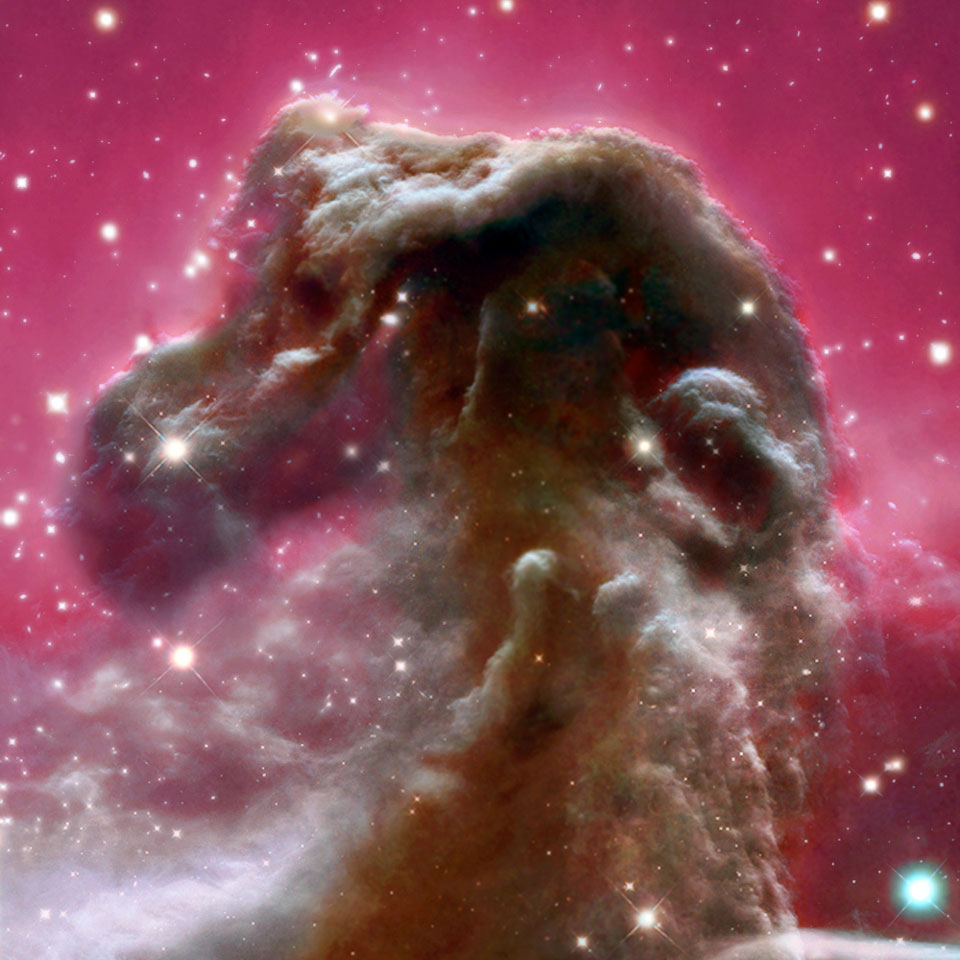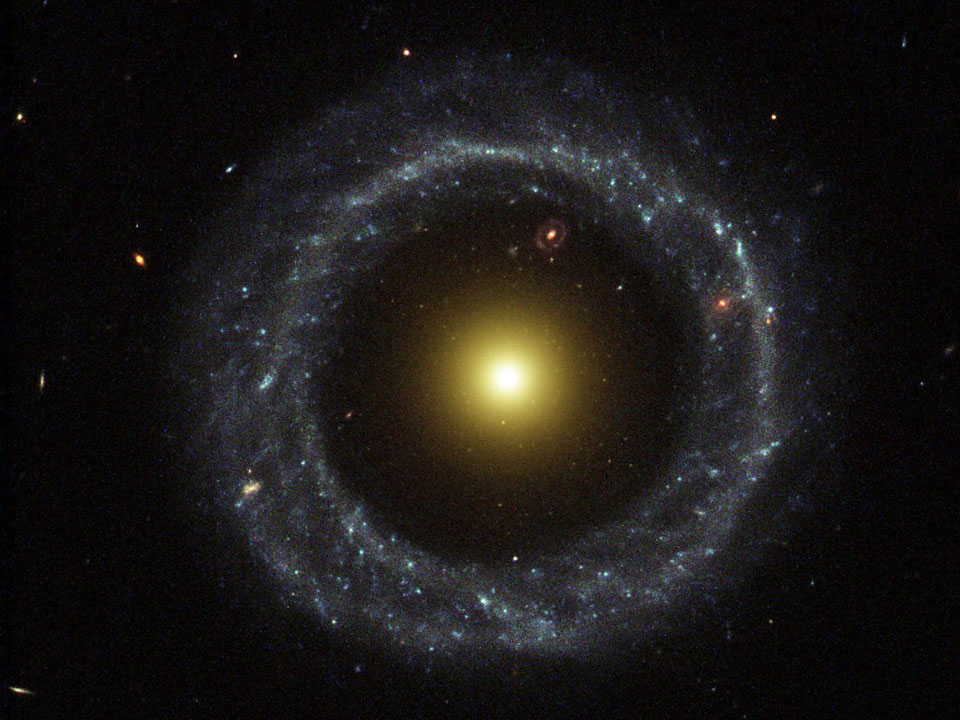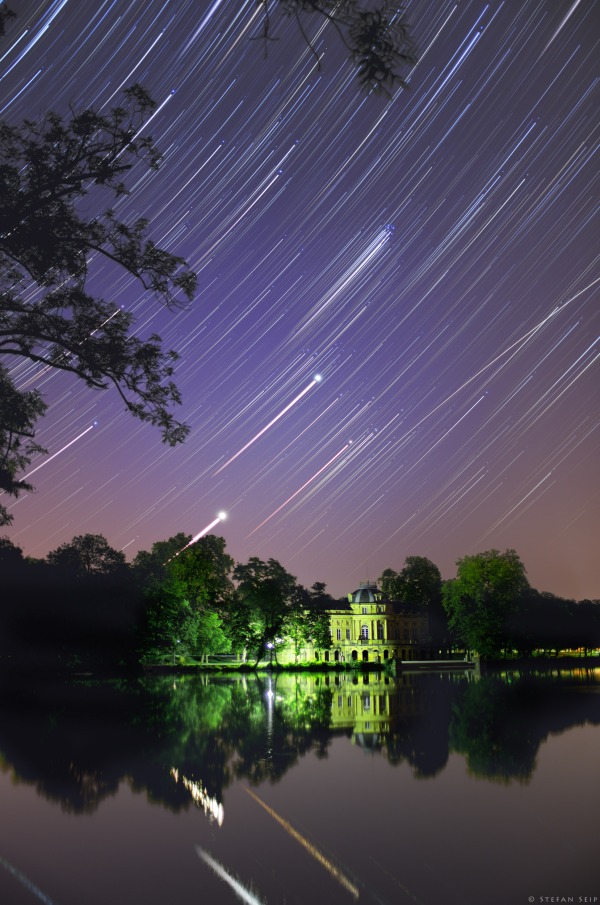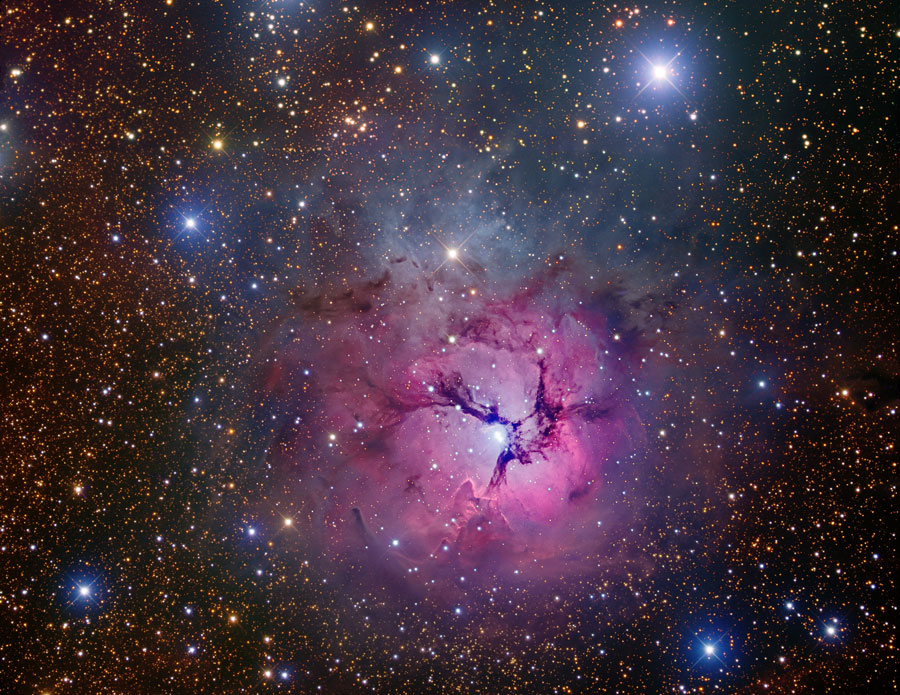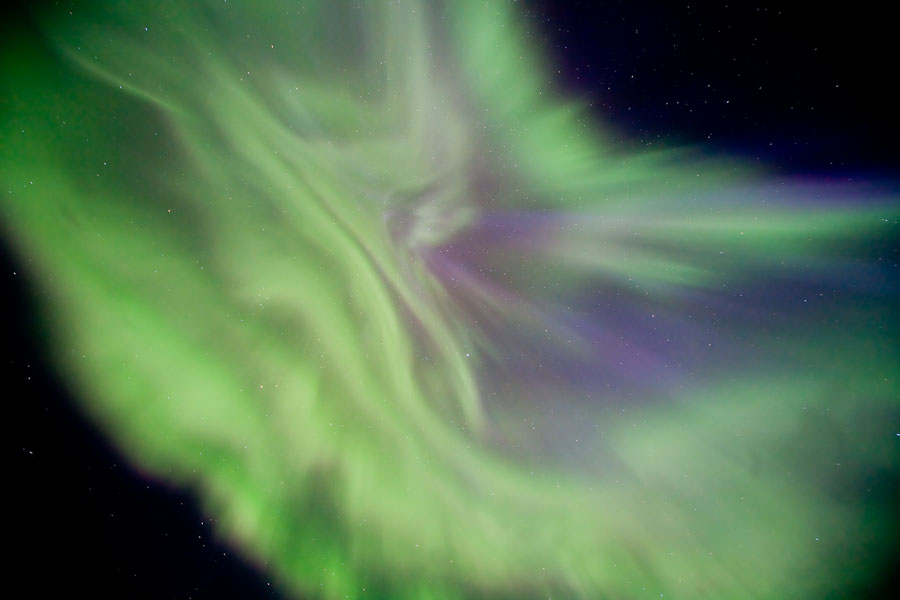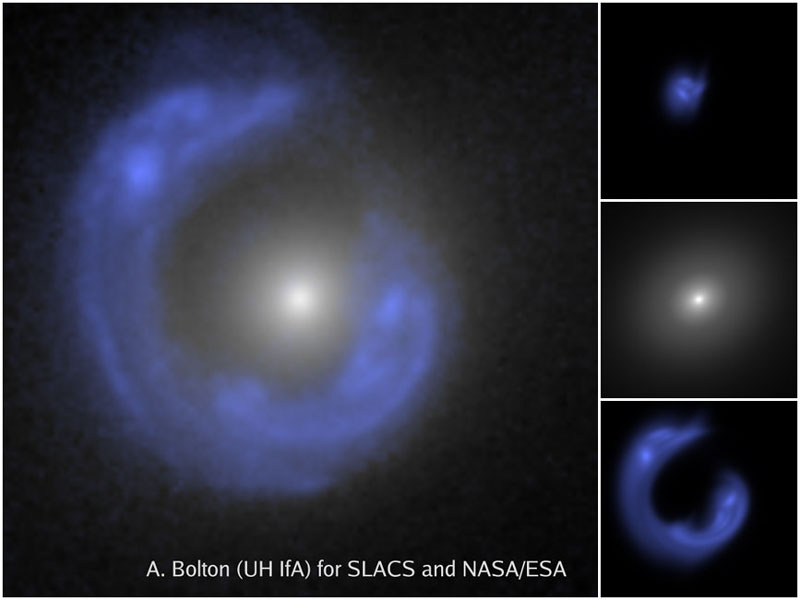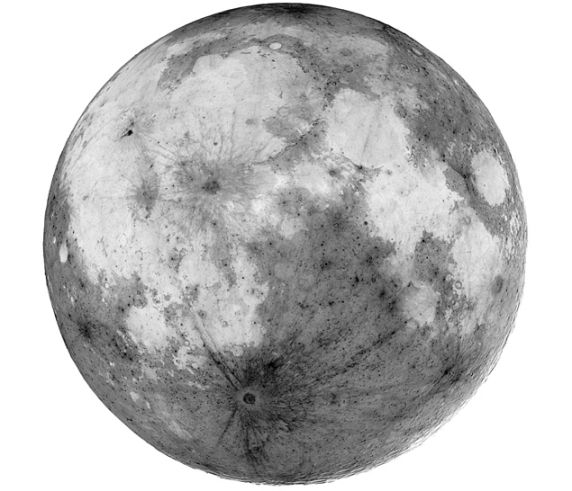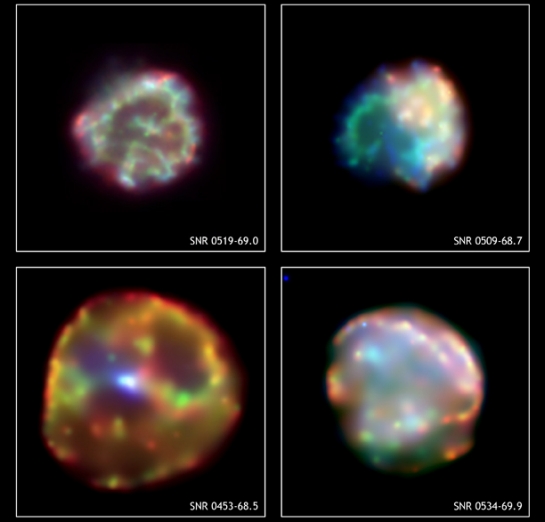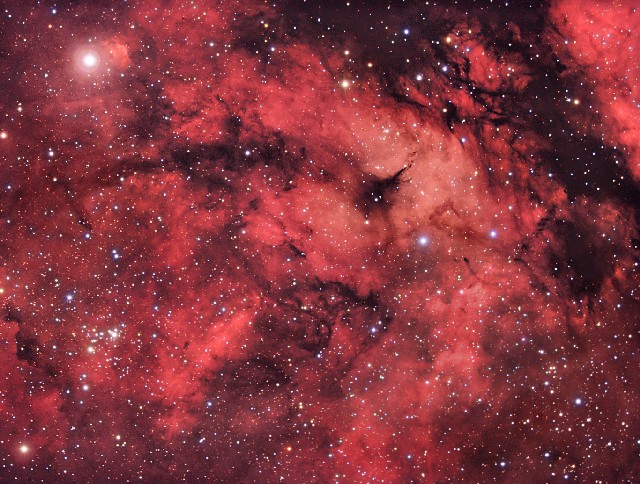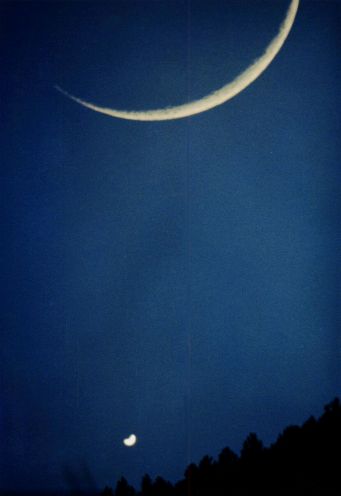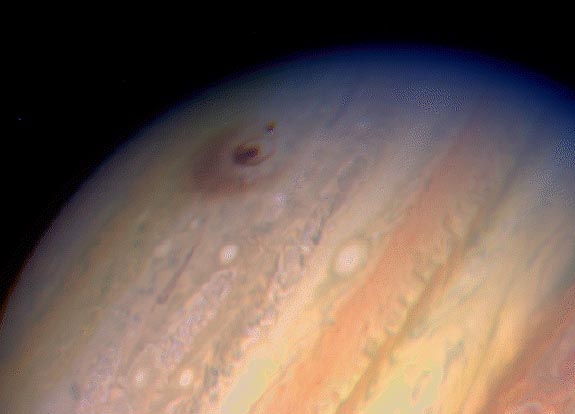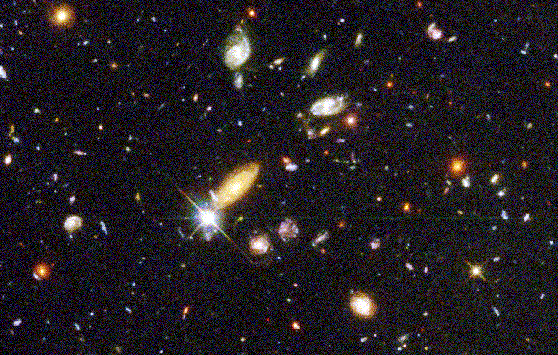| << Previous | Index | Next >> |
2015 What's happening over Bryce Canyon? Two different optical effects that were captured in one image taken earlier this month. Both effects needed to have the Sun situated directly behind the photographer. The nearest apparition was the common rainbow, created by sunlight streaming from the setting sun over the head of the photographer, and scattering from raindrops in front of the canyon. If you look closely, even a second rainbow appears above the first. More rare, and perhaps more striking, are the rays of light that emanate out from the horizon above the canyon. These are known as anticrepuscular rays and result from sunlight streaming though breaks in the clouds, around the sky, and converging at the point 180 degrees around from the Sun. Geometrically, this antisolar point must coincide with the exact center of the rainbows. Located in Utah, USA, Bryce Canyon itself contains a picturesque array of ancient sedimentary rock spires known as hoodoos.
2014
2013 Is this one galaxy or two? This question came to light in 1950 when astronomer Art Hoag chanced upon this unusual extragalactic object. On the outside is a ring dominated by bright blue stars, while near the center lies a ball of much redder stars that are likely much older. Between the two is a gap that appears almost completely dark. How Hoag's Object formed remains unknown, although similar objects have now been identified and collectively labeled as a form of ring galaxy. Genesis hypotheses include a galaxy collision billions of years ago and the gravitational effect of a central bar that has since vanished. The above photo taken by the Hubble Space Telescope in July 2001 revealed unprecedented details of Hoag's Object. More recent observations in radio waves indicate that Hoag's Object has not accreted a smaller galaxy in the past billion years. Hoag's Object spans about 100,000 light years and lies about 600 million light years away toward the constellation of the Snake (Serpens). Coincidentally, visible in the gap (at about one o'clock) is yet another ring galaxy that likely lies far in the distance.
2012 Brilliant Venus and bright Jupiter still rise together before dawn. The peaceful waters by a small lakeside house near Stuttgart, Germany reflect their graceful arcing trails in this composited series of exposures, recorded on the morning of July 26. A reflection of planet Earth's rotation on its axis, the concentric trails of these celestial beacons along with trails of stars are punctuated at their ends by a separate final frame in the morning skyview. Easy to pick out, Venus is brightest and near the trees close to the horizon. Jupiter arcs above it, toward the center of the image along with the compact Pleiades star cluster and V-shaped Hyades anchored by bright star Aldebaran. One trail looks wrong, though. Not concentric with the others and so not a reflection of Earth's rotation, the International Space Station streaks off the right side of this scene, glinting in sunlight as it orbits planet Earth.
2011 Fantastic shapes lurk in clouds of glowing hydrogen gas in NGC 6188. The emission nebula is found near the edge of a large molecular cloud, unseen at visible wavelengths, in the southern constellation Ara, about 4,000 light-years away. Massive, young stars of the embedded Ara OB1 association were formed in that region only a few million years ago, sculpting the dark shapes and powering the nebular glow with stellar winds and intense ultraviolet radiation. The recent star formation itself was likely triggered by winds and supernova explosions, from previous generations of massive stars, that swept up and compressed the molecular gas. Joining NGC 6188 on this cosmic canvas is rare emission nebula NGC 6164, also created by one of the region's massive O-type stars. Similar in appearance to many planetary nebulae, NGC 6164's striking, symmetric gaseous shroud and faint halo surround its bright central star at the upper right. The field of view spans about two full Moons, corresponding to 70 light years at the estimated distance of NGC 6188.
2010 Unspeakable beauty and unimaginable bedlam can be found together in the Trifid Nebula. Also known as M20, this photogenic nebula is visible with good binoculars towards the constellation of Sagittarius. The energetic processes of star formation create not only the colors but the chaos. The red-glowing gas results from high-energy starlight striking interstellar hydrogen gas. The dark dust filaments that lace M20 were created in the atmospheres of cool giant stars and in the debris from supernovae explosions. Which bright young stars light up the blue reflection nebula is still being investigated. The light from M20 we see today left perhaps 3,000 years ago, although the exact distance remains unknown. Light takes about 50 years to cross M20.
2009 Few auroras show this level of detail. Above, a standard digital camera captured a particularly active and colorful auroral corona that occurred last week above Alberta, Canada. With a shape reminiscent of a flower, the spectacular aurora had an unusually high degree of detail. The vivid green and purple auroral colors are caused by high atmospheric oxygen and hydrogen reacting to a burst of incoming electrons. Many photogenic auroras have been triggered from a solar wind stream that recently passed the Earth. The auroras were unexpected because the initiating Sun has been unusually quiet of late.
2008 What's large and blue and can wrap itself around an entire galaxy? A gravitational lens mirage. Pictured above on the left, the gravity of a normal white galaxy has gravitationally distorted the light from a much more distant blue galaxy. More normally, such light bending results in two discernable images of the distant galaxy, but here the lens alignment is so precise that the background galaxy is distorted into a nearly complete ring. Since such a lensing effect was generally predicted in some detail by Albert Einstein over 70 years ago, such rings like SDSSJ1430 are now know as Einstein Rings. SDSSJ1430 was discovered during the Sloan Lens Advanced Camera for Surveys (SLACS) campaign, an observation program that inspected lens candidates found by the Sloan Digital Sky Survey (SDSS) with the Hubble Space Telescope's ACS. Strong gravitational lenses like SDSSJ1440 are more than oddities -- their multiple properties allow astronomers to determine the mass and dark matter content of the foreground galaxy lenses. Given these determinations, SLACS data has now been used, for example, to show that dark matter fraction increases with overall galaxy mass. The inset images on the right depict, from top to bottom, a computer reconstructed image of what the background blue galaxy really looks like, just the white foreground galaxy, and just the lensed blue background galaxy.
2007 The brilliant full Moon might not look quite like this to skygazers next Monday, but the image is a mosaic of 18 digital frames recorded when the Moon was only about seven hours past its exact full phase or time of maximum illumination as viewed from Earth. Here, the pixel values corresponding to light and dark areas have been translated in reverse, or inverted, producing a false-color representation reminiscent of a black and white photographic negative. Normally bright rays from the large crater Tycho dominate the southern (bottom) features as easily followed dark lines emanating from the 85 kilometer diameter impact site. Normally dark lunar mare appear light and silvery. Traditionally, astronomical images recorded on photographic plates were directly examined in this negative color scheme, which can help the eye pick out faint details.
2006 These four panels show x-ray images of expanding cosmic debris clouds, tens of light-years across, in nearby galaxy the Large Magellanic Cloud. The supernova remnants (SNRs) are the results of two types of stellar explosions and are arranged in order of apparent age or the time since light from the initial explosion first reached planet Earth. Clockwise starting at the upper left are remnants aged 600 years, 1,500 years, 10,000 years and 13,000 years. The first three result from a Type Ia explosion - the destruction of a white dwarf star by a thermonuclear blast triggered by mass accreted from a stellar companion. The fourth (lower left) is a Type II explosion - triggered by the final collapse of the core of a massive star. A neutron star, the remnant of the collapsed core, lies at its center.
2005 Ghostly in appearance, Abell 39 is a remarkably simple, spherical nebula about five light-years across. Well within our own Milky Way galaxy, the cosmic sphere is roughly 7,000 light-years distant toward the constellation Hercules. Abell 39 is a planetary nebula, formed as a once sun-like star's outer atmosphere was expelled over a period of thousands of years. Still visible, the nebula's central star is evolving into a hot white dwarf. Although faint, the nebula's simple geometry has proven to be a boon to astronomers exploring the chemical abundances and life cycles of stars. In this deep image recorded under dark night skies, very distant background galaxies can be found -- some visible right through the nebula itself.
2004 In the constellation of the swan near the nebula of the pelican lies the gas cloud of the butterfly surrounding a star known as the hen. That star, given the proper name Sadr, is visible to the unaided eye but found here as the brightest object on the upper left. Sadr, at 1500 light years distant, is near the center of the Butterfly Nebula (IC 1318) in a bright region given the comparatively staid label of IC 1318B. The fantastic starfield that surrounds Sadr contains stars old and young, an open cluster of stars (NGC 6910 visible on the image left), vast clouds of hydrogen gas that glow red, and picturesque pockets and filaments of dark dust. The above image is a digital fusion of several different color images of the gamma Cygni (Sadr) region.
2003 Next stop: Mars. Last month the first of two missions to Mars was launched from Cape Canaveral, Florida, USA above a Boeing Delta II rocket. Pictured above, solid fuel boosters are seen falling away as light from residual exhaust is reflected by the soaring rocket. The Mars Exploration Rover dubbed Spirit is expected to arrive at the red planet this coming January. Upon arriving, parachutes will deploy to slow the spacecraft and surrounding airbags will inflate. The balloon-like package will then bounce around the surface a dozen times or more before coming to a stop. The airbags will then deflate, the spacecraft will right itself, and the Spirit rover will prepare to roll onto Mars. The robotic Spirit is expected to cover as much as 40 meters per day, much more than Sojourner, its 1997 predecessor. Spirit will search for evidence of ancient Martian water, from which implications might be drawn about the possibility of ancient Martian life. A second rover named Opportunity was successfully launched on July 7 and will arrive at Mars a few weeks later.
2002 No one knows for sure what caused this signal. There is a slight possibility that it just might originate from an extraterrestrial intelligence. The bright colors on the blue background indicate that an anomalous signal was received here on Earth by a radio telescope involved in a Search for Extraterrestrial Intelligence (SETI). A search for these signals is ongoing by several groups including volunteer members of the SETI League. Time labels the vertical axis of the above plot, and frequency marks the horizontal axis. Although this strong signal was never positively identified, astronomers have identified in it many attributes characteristic of a more mundane and ultimately terrestrial origin. In this case, a leading possibility is that the signal originates from an unusual modulation between a GPS satellite and an unidentified Earth-based source. Many unusual signals from space remain unidentified. No signal has yet been strong enough or run long enough to be unambiguously identified as originating from an extraterrestrial intelligence.
2001 While stationed in central Africa in December 1944, Norman Appleton witnessed a meteor so bright he remembered it his entire life. Right before his eyes a tremendous smoking fireball streaked across the daytime sky. Years later, as an accomplished member of the Guild of Aviation Artists, he recorded his memories in the above painting. Several days ago, on July 23 at 6:19 pm EDT, a daytime fireball visible from the northeast United States was reported by many personal accounts. No pictures of this event have yet surfaced, although it is quite possible that a video security camera somewhere caught it serendipitously. The bolide was likely caused by a sofa-sized rocky meteor disintegrating as it fell to Earth, an event that occurs over some unpopulated area almost every day.
2000 July is drawing to a close and in the past few days, some early morning risers could have looked east and seen a crescent Moon sharing the pre-dawn skies with planets Jupiter and Saturn. Planet Mercury will also pass about 2 degrees from the thin waning crescent Moon just before sunrise near the eastern horizon on Saturday, July 29. And finally, on the evening of July 31st, Venus will take its turn near the crescent Moon. But this time it will be a day-old crescent Moon near the western horizon, shortly after sunset. In fact, on July 31 (August 1 Universal Time) the Moon will occult (pass in front of) Venus for northwestern observers in North America. This telescopic picture taken on 31 December 1997, shows a lovely young crescent Moon and brilliant crescent Venus in the early evening sky near Bursa, Turkey.
And what about the Sun? On Sunday, July 30, a partial eclipse of the Sun will be visible from some locations in North America.
1999 This is what Asia looks like at night! Can you find your favorite Asian city? Although not all of Asia is shown, city lights might make this task possible. The above picture is actually a composite of over 200 images made by satellites orbiting the Earth. Scans were made by the USAF Defense Meteorological Satellite Program (DMSP) Operational Linescan System. The DMSP satellites continue to help in the understanding and prediction of weather phenomena as well as provide key information about population patterns, city light levels, and even rural forest fires.
1998 In 1993, a strange string of comet pieces was discovered near the planet Jupiter. So unusual a sight, Comet Shoemaker-Levy 9 (SL9) quickly became the object of much scientific curiosity. Studies showed that the Sun would soon perturb the orbit of SL9 so that it would actually strike Jupiter in July 1994. The studies were right. The above picture shows the impact site of SL9's fragment G on Jupiter's cloud-tops. The size of the dark outer ring is roughly the size of the Earth. Since Jupiter is mostly gas, the comet melted and evaporated before plunging too far into Jupiter's atmosphere.
1997 Turn on your camcorder, go outside, and become an astronomer. How?. Tomorrow morning, our Moon will pass directly in front of Aldebaran, the brightest star in this picture and in entire constellation of Taurus. Aldebaran is visible to the left and below Comet Hale-Bopp in the above photograph, which was taken on April 30th in Tenerife, Spain. This occultation is valuable because disappearance times from different locations can be used to map the height of the lunar terrain at the occultation points. You can help by clicking here, where a site will detail how to tape a familiar cable channel and then take your still-running camcorder outside to tape the occultation of Aldebaran by the Moon. You can then donate your VCR tape to science by mailing it to this address. Leave yourself plenty of time for a practice run and be sure to check the weather before going to a lot of trouble!
1996 "We had the sky up there, all speckled with stars, and we used to lay on our backs and look up at them, and discuss about whether they was made or only just happened." (from Mark Twain's The Adventures of Huckleberry Finn)
Even the faintest stars Huck and Jim could see as their raft drifted down the Mississippi were in our own Galaxy. The faintest objects astronomers can see today are the distant galaxies -- entire systems of stars comparable to our own Milky Way, which fill the Universe. Despite the advances, the sense of wonder so simply expressed in Huck's musing is still the same.
1995 Not all galaxies have spiral structure like our Milky Way. Many have smooth elliptical shapes, but also many have irregular shapes such as the bright sky object M82, the 82nd object on Messier's list. The strange structure of this galaxy is thought to be caused by young stars ejecting gas in energetic bubbles, and by lanes of absorbing dust.
| << Previous | Index | Next >> |

